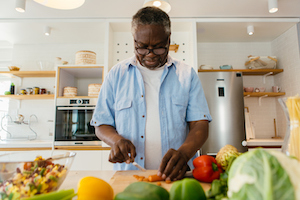Healthy Eating Tips for People With Diabetes: Part 2
By Hope Warshaw
 Experts Susan Weiner and Janice MacLeod discuss increasing your fiber intake, food prep, and how best to use the services of a certified diabetes care and education specialist.
Experts Susan Weiner and Janice MacLeod discuss increasing your fiber intake, food prep, and how best to use the services of a certified diabetes care and education specialist.
Figuring out what to eat with diabetes can be daunting – so in part two of our series on healthy eating tips, we spoke with two more leading dietitians who work with people with diabetes to gain some insight into what they recommend.
They’ve spent years caring for and counseling people with diabetes, and are involved nationally in myriad volunteer efforts to communicate the art and science of diabetes care.
 Susan Weiner
Susan Weiner
Weiner is the owner of Susan Weiner Nutrition, PLLC, a private practice based in New York. Weiner’s clientele includes people living with diabetes, heart disease and gastrointestinal disorders. She is well known nationally for her involvement with several diabetes organizations and writes the successful “Diabetes in Real Life” column for Endocrinology Today.
Question: What are a few recommendations you give clients to increase their consumption of fiber?
Weiner: I offer clients several ideas. It’s not easy to get to the 25 to 30 grams of fiber per day recommended for adults. Most people don’t come anywhere close! The foods that contain a good bit of fiber are generally carbohydrate-containing foods including vegetables of all kinds, fruits, whole grains, legumes and beans. In addition, nuts contain some fiber, next to no carbohydrates, but (be careful!) they’re high in fat and calories. Choose unsalted nuts to reduce sodium.
-
Eat more greens! Try relatively low in carbohydrate, high in fiber leafy greens, such as collard, mustard and turnip greens, kale, spinach, or arugula. There’s a variety, so mix up your choices. You’re bound to find one you’ll enjoy.
-
Sprinkle chia or ground flax seeds on your vegetables, or Greek yogurt. Beyond a source of fiber, they offer a satisfying, crunchy texture.
-
Use cauliflower in a new way by making “cauliflower mashed potatoes.” It’s easy! Cook the cauliflower as you want, mash it, and add a small amount of low sodium vegetable broth, minced garlic and pepper to desired taste. Bonus tip: add a bit of extra sharp shredded cheddar cheese for a creamier taste.
-
Nibble on nuts. Nuts are a high protein, low carbohydrate, high fiber snack. They are non-perishable and a great ‘to-go’ snack in small quantities.
Question: What are steps a person with diabetes can take to eat more plant-based foods but hold the line on carbohydrates?
Weiner: Here are a few suggestions:
-
Integrate nuts (almonds, walnuts, cashews, pecans, Brazil and pistachio nuts) into meals and snacks. Chopped nuts add crunch and can be a good topper for vegetables, fruit and yogurt, stir-fry entrees and more. To optimize the flavor of nuts, roast them. If you’ll use small pieces of nuts, chop before roasting. Use nut butters (peanut, almond or cashew butter), seeds (ground or whole Hemp, chia, flax or sesame).
-
Choose more low carbohydrate, high fiber vegetables throughout the day, not just at your evening meal. Put chopped frozen spinach into an omelet or egg scramble, top a grilled cheese with tomatoes, and use baby carrots or small tomatoes for a quick and easy lunch side. Top salads with beans, legumes and pulses (chickpeas, black beans, green peas, or lentils work well). Keep in mind they’re higher in carbohydrates than most vegetables…but so darn healthy!
-
Cut down on red meat by using tofu, soy nuts, or tempeh.
Question: How can people with diabetes find and use the services of a RDN who has expertise in diabetes care and education (CDCES)?
Weiner: A RDN who is also a CDCES, has unique understanding of, and expertise in, food and nutrition, as well as diabetes care. Find an RDN, CDCES who understands the importance of using a person-centered, collaborative approach and ask your PCP or others with diabetes for their recommendations. This approach is important when you want to make realistic changes in your food choices and eating habits.
RDNs deliver a service formally called Medical Nutrition Therapy (MNT). MNT for people who have diabetes is covered by Medicare Part B for beneficiaries and is covered by many private health plans.
In addition to the MNT service, people with diabetes can also often take advantage of another service, Diabetes Self-Management Education and Support (DSMES). DSMES is often provided within a program, but increasingly (and due to telehealth) can be delivered one on one. Here’s a national resource you can use to find a DSMES program in your area.
 Janice MacLeod
Janice MacLeod
MacLeod is head of Clinical Advocacy in Global Professional Affairs & Clinical Education for Medtronic’s Diabetes Group. She has contributed widely as a volunteer with the Association of Diabetes Care & Education Specialists and the Academy of Nutrition and Dietetics. MacLeod is the current chair of the Diabetes Dietetic Practice Group, a subgroup of the Academy.
Question: What are good ways for people to use glucose monitoring (blood glucose monitoring [BGM] or continuous glucose monitoring [CGM]) to obtain data to help them observe how the foods and meals they eat impact their glucose levels?
MacLeod: Always check your glucose with a reason for doing so. Is it to check before or after meal glucose, because you feel symptoms of low or high glucose, or you want to see how a food or meal impacts your glucose at one hour and then three or more hours?
One of the best ways to use BGM is by using paired checking. This means doing a BGM check before and two hours after a chosen meal, or before and after physical activity or other regular events you do in your life. The paired checks allow you to see cause and effect. Consider paired checks as an experiment and simply data points.
Ideally, your glucose level should rise no more than 50 points from before eating to two hours after. Paired checks before and after any type of physical activity, such as a walk, that shows that exercise lowered your glucose level can be motivating. Paired checking before bedtime and again fasting the next morning can show if your medication plan, particularly long-acting insulin if you take it, is working to help you hit your targets.
CGM can be even more helpful because it provides glucose results every few minutes. You can review how your glucose changes over a few hours or days to see trends. The ability to observe glucose levels in real time along with an arrow indicating the direction your glucose is heading and how fast, can help you make the optimal decisions throughout the day about how to balance your food, physical activity, and glucose lowering medications, particularly insulin.
The ADA’s Standards recommends CGM use for all people who take insulin.
Question: It’s become so easy to eat meals and snacks away from home, yet research shows restaurant meals can be higher in refined grains, unhealthy fats, and salt/sodium and lower in vegetables, fruit and dairy foods. What are your practical tips to make food preparation at home quicker and easier?
MacLeod: Try to make as many delicious and healthy meals at home as possible. Even if you do not see yourself as a “cook,” put meals together by thoughtfully stocking your kitchen and setting aside a bit of time to do the preparation. Use these tips:
-
Shop fresh and frozen. Use your chosen market to buy fruits and vegetables in season and other fresh foods, like fish, meats, and herbs. A few go-to vegetables are the antioxidant-rich and nutrient-dense dark leafy greens and cruciferous vegetables, like broccoli, cauliflower and cabbage. But don't discount frozen foods as inferior in quality. They’re just as nutritious and perhaps more convenient and budget-friendly.
-
Stock your pantry wisely: To always have ingredients on hand for quick-to-fix meals, fill your pantry with dry staples like whole grain brown rice, quinoa, lentils, dried beans and even canned fruits and vegetables. Choose products with no added sugars and low in sodium. Shop for and buy these items in bulk online or at food co-ops. Keep an inventory of what you stock in your pantry, stock up as you need so you don’t run out.
-
Season foods simply: Rather than using store-bought and generally pricey dressings and sauces, typically full of added sugars and high in sodium, use simple ingredients that pack extra flavor. For example, to dress green salads, squeeze some fresh lemon or orange for a kick of citrus. Mash ripe avocado and use it as a healthy sandwich spread. Use dry or fresh herbs, such as rosemary, cilantro, basil, sage or parsley to boost flavor. Better yet, try to grow a few herbs you enjoy.
-
Batch prep, portion, and freeze: A tried-and-true strategy for healthy, appropriately portioned meals is batch cooking. This creates meals to have on hand when you don’t have time to cook. When it comes to a ratio for portions of each food group, think of the plate as a pie chart to achieve the "ideal plate ratio;" half of it should be vegetables, cooked or raw, one-quarter should be protein (about three to four ounces of protein). The other quarter can be healthy grains or more vegetables.
Question: When and how often should a person with diabetes seek and get Medical Nutrition Therapy (MNT) and Diabetes Self-Management Education and Support (DSMES)?
MacLeod: A consensus report published by seven health professional organizations whose members care for and counsel people with diabetes, recommends that you be referred to these services at these key times:
-
When diagnosed
-
Annually or if treatment targets are not being met
-
When complicating conditions develop
-
When transitions in life and care occur
Both MNT and DSMES are services that many people have access to. Unfortunately, far too few people know about and take advantage of these services, yet they’re often covered by your health plan. Learn about these services and ask your diabetes healthcare providers for referrals. You’ll be glad you did.
For more helpful advice from top nutrition experts, you can read part 1 of our healthy eating tips series here.








